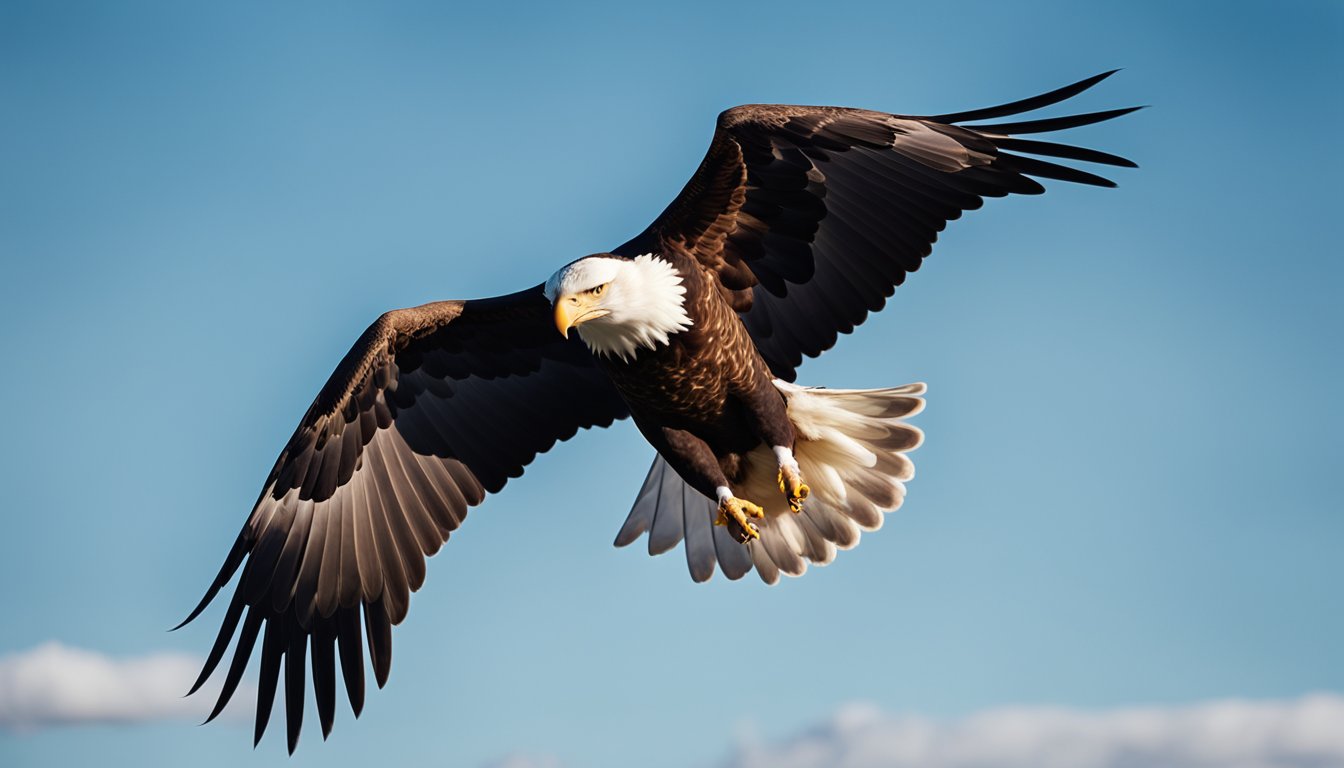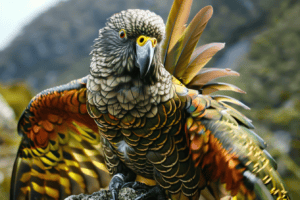The Bald Eagle, or Haliaeetus leucocephalus, is a bird that captures our hearts and imaginations.
When we think of the Bald Eagle, we often picture a powerful and noble creature gliding high above, with its brilliant white head and tail shining against the vast blue sky.
More than just a bird, the Bald Eagle stands as the revered national symbol of the United States, chosen for its strength and freedom.
Since 1782, this majestic bird has not only symbolized our nation’s values but has also been a source of inspiration for people across the nation.

Growing up, we’ve seen images of the Bald Eagle on everything from coins to flags, reminding us of the wild and beautiful landscapes where these birds thrive.
Have you ever wondered why it’s called “Bald” when it actually has a full head of white feathers?
It’s because “bald” used to mean “white” in old English.
These incredible raptors are not only known for their distinctive look but also for their remarkable life cycle and behaviors.
They build some of the largest nests of all bird species, and they find a partner to mate with for life – isn’t that romantic?
From their majestic presence to their fascinating behaviors, Bald Eagles have a lot to teach us about resilience and beauty in nature.
Did you know that they have an amazing comeback story?
Once on the brink of extinction in the U.S., these birds have bounced back thanks to conservation efforts and the banning of harmful pesticides.
Now, we can once again spot them soaring majestically in our skies, a testament to what we can achieve when we come together to protect our wildlife.
So the next time we see a Bald Eagle, let’s take a moment to appreciate this stunning bird that represents the spirit of the land we call home.
Physical Characteristics and Behaviors

Have you ever seen a bird that makes you go “Wow!”? That’s what we often feel when we spot the majestic Bald Eagle.
With its striking features and impressive behaviors, this bird is a marvel of nature that never fails to dazzle us.
Majestic Appearance
Picture this: a magnificent bird with a snowy white head, a sharp yellow beak, and intense eyes to match.
That’s our Bald Eagle for you!
Its plumage is not all white; its body and wings are a deep chocolate brown, creating a sharp contrast that’s easy to spot in the sky.
Females usually show off a greater wingspan, which can reach a whopping eight feet wide!
Survival Skills
Bald Eagles are not only about looks; they have some serious survival skills.
Their powerful talons and strong feet are their main tools for fishing, which is their preferred meal.
It’s fascinating to watch them swoop down over the water and snatch a fish with precision.
When food is scarce, they’re not above soaring down to steal a meal from another bird or feasting on carrion.
From Nesting to Flight
Our eagle friends are quite the homebuilders.
Their nesting habits include creating giant structures in tall trees or even on cliff sides.
Constructing these nests can be a real team effort between the eagle parents.
Once eggs are laid, both parents take turns with incubation, keeping their future chicks warm and safe.
And when it’s time for the little ones to learn flight, it’s a family affair, with both parents teaching and encouraging their young until they can soar on their own.
Habitat and Diet

We’re about to explore where bald eagles make their homes and what they love to eat.
Get ready to discover some fascinating tidbits about these glorious birds!
Home Across North America
Our majestic bald eagles aren’t picky about where they live, as long as there’s water nearby. Why, you ask?
Because whether it’s a lake, a river, or a coastline, these places are like all-you-can-eat buffets for them!
In the United States, you can spot bald eagles across all 48 lower states, Alaska, and even neighboring Canada and northern Mexico.
They’re fans of tall trees by the water for the best fish-spotting view.
- Preferred Habitats:
- Lakes & Rivers: Perfect for fishing
- Coastlines: More fish and food variety
- Tall Trees: For secure nesting
Bald Eagle’s Menu
When it comes to mealtime, fish top the menu, especially a delicious salmon.
But don’t think these birds aren’t versatile in their tastes!
If they spot something scrumptious, like small mammals or other birds’ leftovers, they’re happy to invite themselves to dinner.
They’re skilled hunters and opportunistic feeders, often seen swooping down with their powerful talons to pluck fish right out of the water.
- Top Prey:
- Fish: The main part of their diet
- Salmon: A favorite treat
- Carrion & Leftovers: Eagles aren’t shy about scavenging
So there you have it!
Whether perched high in a tree by the river or circling over a lake, bald eagles are always on the lookout for their next fishy feast, making their habitat just as important as their diet.
Conservation and Symbolism

Before we soar into our story, let’s nest down on a couple key feathers: The Bald Eagle is not just our national bird and symbol of power and freedom, it’s also an incredible conservation success story born from the strong protections of the Endangered Species Act.
A Conservation Success Story
Imagine the skies without the Bald Eagle — hard to picture, right?
Well, once upon a time, our winged icon was in danger due to the use of DDT, a pesticide harmful to eaglets.
This led to their inclusion as an endangered species. But we flapped back!
With the ban on DDT and the help of the Endangered Species Act, we’ve watched the Bald Eagle numbers soar to new heights.
Today, they’re a testament to how our protection measures can make the skies friendlier for feathered friends!
Symbols in American Culture
The Bald Eagle spreads its wings not just in the wild but over our entire American culture.
It’s not just any bird — it’s our national bird.
Chosen by Congress in 1782, it flies proudly on our Great Seal, official seal, and other symbols like the flag and the seal of the United States.
This majestic bird embodies freedom, justice, and strength.
Every time we see an eagle, whether on a wild adventure or a shiny coin, it reminds us of our shared spirit and values.
Isn’t it amazing to think how this bird connects us all?
Bald Eagles in American History
The bald eagle isn’t just any bird; it’s a powerful symbol that has soared through America’s history.
Our nation has embraced this majestic bird as a sign of strength and freedom.
Let’s take a flight through time and discover how the bald eagle became an American icon.
From Past to Present
Imagine it’s June 20, 1782, and we’re in a room where history is being made. Congress is about to make a big decision.
In front of them is the design for the Great Seal of the United States.
This seal will represent everything our young country stands for.
They’ve chosen the bald eagle to be front and center. Why?
Because it’s strong, noble, and native to North America – just like us!
Now, not everyone thought the bald eagle was the perfect choice. Benjamin Franklin, for one, had his doubts.
He wrote a letter to his daughter expressing his views that the bald eagle had a bit of a reputation for being a bit of a thief in the bird world.
Franklin saw the turkey as a more respectable bird.
But despite Franklin’s concerns, the majority ruled, and the bald eagle became our national bird and a central figure on the seal of the United States.
Thomas Jefferson and others in the Continental Congress had a vision for America, and the bald eagle fit right in.
They saw an American eagle that was majestic, and fierce in its own right, just like the country it would come to symbolize.
Fast forward to today, and the bald eagle still holds that special place in our hearts and on our official symbols.
From coins to flags, it reminds us of our history and the freedoms we cherish. How cool is that?
Frequently Asked Questions
We’ve gathered some of the most common curiosities about our nation’s emblem, the bald eagle, to answer them for you.
Let’s explore these fascinating features of this majestic bird together.
What makes the bald eagle a significant symbol for the United States?
The bald eagle represents strength, freedom, and longevity, which are ideals that resonate with the American spirit.
Designated as the national symbol of the United States in 1782, its image graces our seals and emblems, instilling a sense of patriotism and unity.
Can you tell me where I might spot a bald eagle living in the wild?
Absolutely! Bald eagles thrive near large bodies of open water with abundant fish, so look for them by lakes, rivers, and coastal areas.
They can be found across North America, but for a memorable sighting, head to states like Alaska and Florida or visit regions detailed in the American Bird Conservancy guide.
When do bald eagles have their mating season, and how do they raise their young?
Mating season for bald eagles usually kicks off in late winter to early spring.
They engage in intricate courtship rituals and, once a pair bonds, they work together to build a nest and raise their young eaglets, teaching them to fly and hunt over several months.
How broad is the territory a bald eagle needs, and why do they need so much space?
Bald eagles require a large territory, often extending several miles, to have enough food and nesting opportunities.
The vast territory supports their hunting lifestyle and helps to minimize conflicts with other eagles.
What kind of activities do bald eagles do during the day?
During the day, bald eagles are busy birds.
They primarily hunt for fish, their favorite meal, by swooping down with their powerful talons.
When they’re not hunting, they might be seen soaring high or perched regally, keeping an eye on their territory.
How can you identify a bald eagle’s nest, and what’s unique about it?
A bald eagle’s nest, or aerie, is an impressive sight!
These nests are usually high in large trees or on cliff edges and can be incredibly large, some reaching over 8 feet across.
Their unique nests are reused and added to each year, creating massive structures that can weigh as much as a car!









